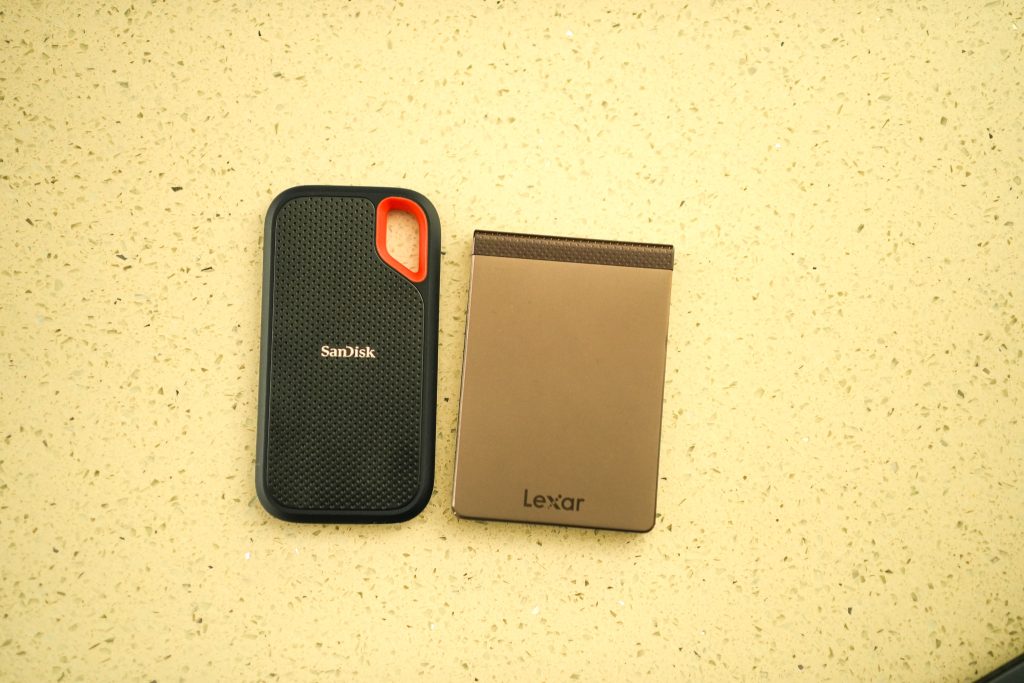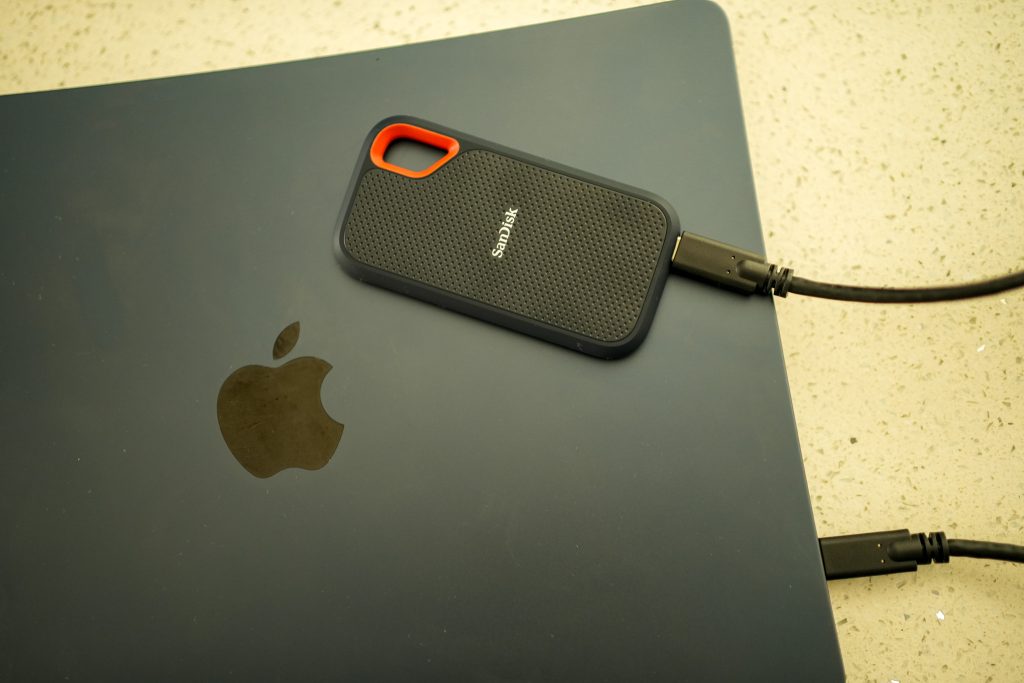There’s something deeply satisfying about finding tech that doesn’t just work well but also looks good doing it. The SanDisk Extreme Portable SSD has been my daily driver for the past few weeks, and it’s quickly become one of those rare gadgets I actually enjoy pulling out of my bag. Coming from my trusty Lexar SL200, I was curious if the switch would be worthwhile – spoiler alert: it absolutely was.
Design & Build: Practical Meets Premium
The first thing that strikes you about the SanDisk Extreme is its distinctive silhouette. While most portable SSDs settle for the “rectangle with rounded corners” approach, SanDisk has created something with actual personality. The drive features a rugged silicone rubber coating with a textured finish that provides excellent grip – no more fumbling with slippery drives when you’re transferring files in a hurry.
The carabiner loop in the top corner is one of those “why doesn’t everything have this?” features. It’s surprisingly sturdy and perfect for attaching to a backpack or camera bag. The orange accent surrounding this loop adds a touch of flair without being, well, out there.

At roughly the size of a credit card (though obviously thicker), the Extreme fits comfortably in a pants pocket or any bag compartment. Too comfortable in fact. I had to check my pockets twice at some point to ensure I hadn’t lost it. Compared to my Lexar SL200, the SanDisk is actually slightly more compact despite offering similar capacity options. The SL200 has a smoother, more business-like aesthetic, but the Extreme’s rugged charm and smaller footprint win out for me.
Portability: Take-Anywhere Toughness
Size matters when you’re constantly on the move, and the SanDisk delivers here. Measuring approximately 100.54 x 52.42 x 8.95mm, it’s compact enough to slip into a jeans pocket or the smallest compartment in your laptop bag. It weighs just around 59 grams – you’ll barely notice it’s there.
What really sets the Extreme apart from my older Lexar SL200 is the durability factor. While the Lexar offers decent protection, the SanDisk comes with IP55 water and dust resistance, plus drop protection up to 2 meters. I’ve (accidentally) tested this claim by knocking it off my desk onto a hardwood floor – not a scratch or hiccup in performance. For outdoor shoots or travel in unpredictable conditions, this level of ruggedness provides serious peace of mind especially for a journalist turned content creator like myself.
Performance: Speed When It Counts
Now, let’s talk numbers – because they’re impressive. The SanDisk Extreme delivers read speeds up to 1050MB/s and write speeds up to 1000MB/s in real-world testing. That’s nearly twice as fast as my previous Lexar SL200, which tops out around 550MB/s.

In practical terms, transferring a 50GB folder of 4K video footage took just under 50 seconds with the SanDisk, compared to nearly two minutes with the Lexar. When you’re backing up on location or transferring large project files between workstations, this difference is genuinely meaningful.
The performance remains consistent even when the drive heats up during extended file transfers – something that can’t be said for all portable SSDs. I ran it through several back-to-back 4K video transfers totaling over 200GB, and it maintained speeds within 5% of its maximum throughout.
The drive connects via USB-C and comes with both USB-C to USB-C and USB-C to USB-A cables, ensuring compatibility with virtually any computer. It’s worth noting that you’ll only get those maximum speeds when connected to a USB 3.2 Gen 2 port – but even on older USB 3.0 connections, it still outperforms many competitors.
The Not-So-Great Stuff
It’s not all sunshine and rainbows, though. The SanDisk Extreme runs noticeably warm during extended transfers. While it never reached concerning temperatures in my testing, it’s something to be aware of if you’re planning marathon backup sessions. Especially if you’re lucky to get your hands on a larger capacity one.
The included SanDisk Security software is functional but feels clunky compared to solutions from competitors like Samsung. The encryption works well enough, but the user interface looks dated and the setup process isn’t particularly intuitive or user friendly.
Another irritation is the short cables that come in the box. At just under 8 inches, they’re adequate for laptop use but frustratingly limiting when connecting to a desktop or dock positioned under a desk. You’ll likely want to invest in a longer cable immediately.
Perhaps most annoying is the lack of any activity indicator light. My Lexar SL200 has a subtle LED that lets you know when data is transferring – the SanDisk offers no visual feedback whatsoever, leaving you to trust that it’s working properly. During large transfers, this absence becomes surprisingly frustrating.

Pricing: Premium But Justified
Let’s address the elephant in the room – the SanDisk Extreme isn’t the cheapest portable SSD out there. Depending on capacity (it’s available in 500GB, 1TB, 2TB, and 4TB options), you’re looking at a price point north of R2499 for the 500GB.
However, after using it for a few weeks, that premium feels justified. The combination of significantly faster transfer speeds, genuine durability, and thoughtful design touches make it worth the extra investment – especially if you work with large files regularly or need storage you can trust in challenging environments.
For professionals who can’t afford to lose data or waste time on slow transfers, the value proposition becomes even clearer. The performance-to-price ratio here is actually quite reasonable when you consider the complete package.
Verdict: A Worthy Upgrade
Moving from my Lexar SL200 to the SanDisk Extreme has been an upgrade in every meaningful way. It’s faster, tougher, slightly more compact, and frankly, just nicer to use day-to-day. The carabiner loop and textured finish might seem like minor details, but they enhance the user experience in ways that make me wonder how I lived without them.
The few negatives – the warmth during extended use, mediocre software, and lack of an activity light – are minor annoyances rather than deal-breakers. They’re worth mentioning but don’t significantly detract from an otherwise excellent product.
I’d give it a solid 8.5 / 10 rating.
You might also like
More from Featured
Samsung Galaxy S25 Ultra Review
You know the feeling. That tiny pause before you peel off the plastic film on a brand-new flagship. That quiet …





